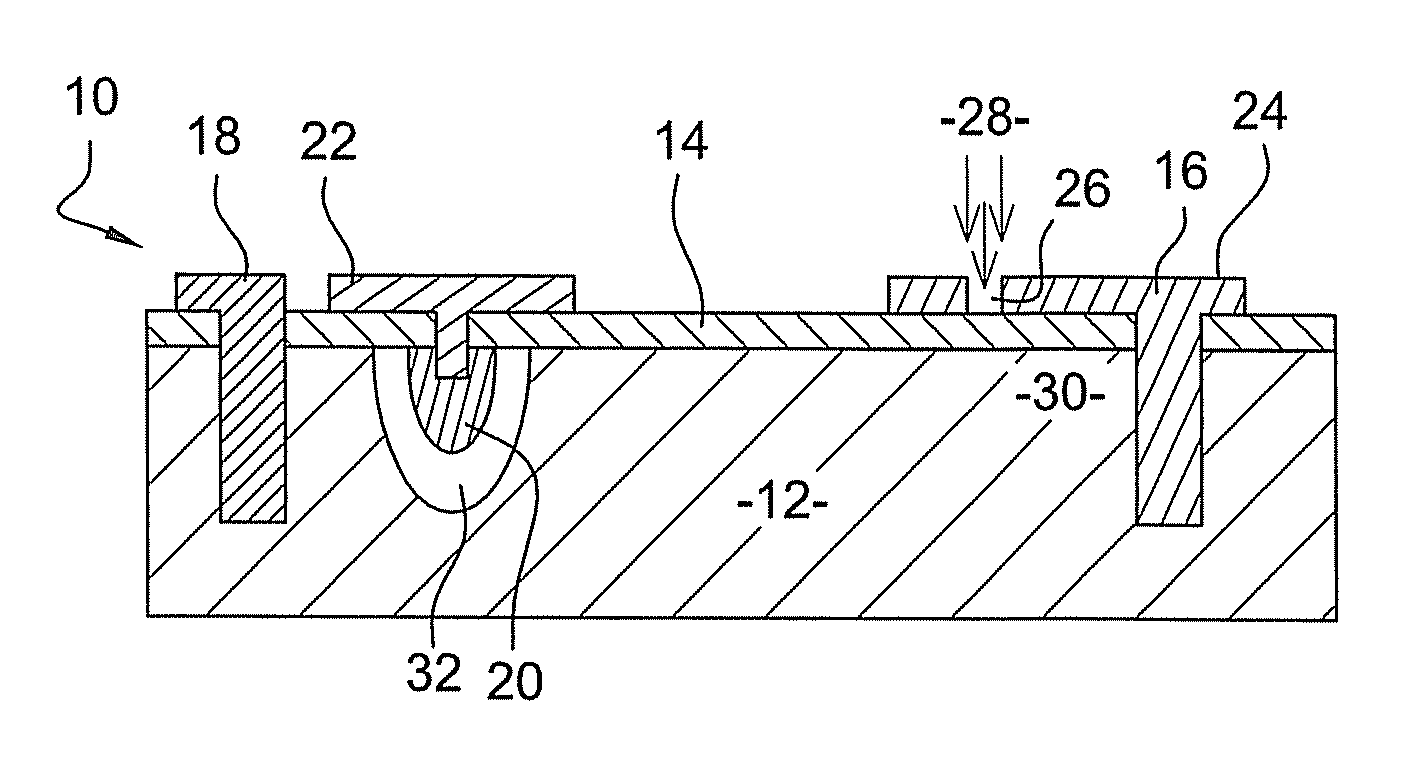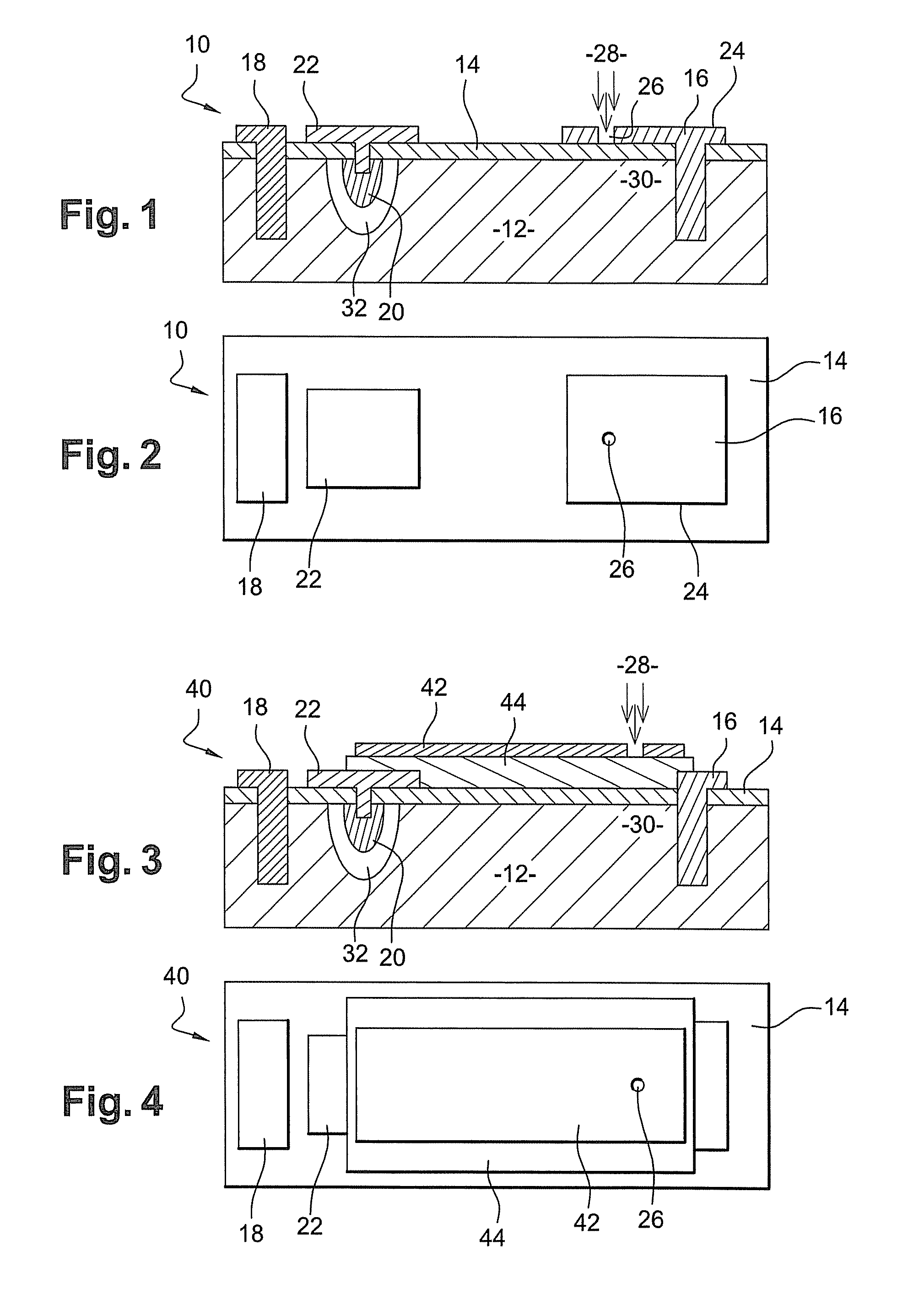Photodetector with internal gain and detector comprising an array of such photodetectors
a photodetector and photodetector technology, applied in the field of photodetectors with internal gain, can solve the problems of low quantum efficiency (generally less than 50%), limited detection wavelength range, bulky photocathode detectors, etc., and achieve low bias voltage, good signal-to-noise ratio, and high gain amplification
- Summary
- Abstract
- Description
- Claims
- Application Information
AI Technical Summary
Benefits of technology
Problems solved by technology
Method used
Image
Examples
first embodiment
[0061]FIGS. 1 and 2 are schematic views of a photodetector with internal gain 10 in accordance with a
[0062]Photodetector 10 comprises semiconductor layer 12 of a first conductivity type, for example P-type conductivity, and a passivation layer 14, made of zinc sulfide (ZnS) for instance, which covers layer 12 and protects it against chemical, mechanical and electrical damage. Two metallic (preferably ohmic) contacts 16, 18, such as gold, for example, are also provided in layer 12; they pass through passivation layer 14 and emerge on the surface of the passivation layer.
[0063]Layer 12 is made of a semiconductor material doped with nearby majority charge carriers which do not produce impact ionization events. Thus, when this layer is subjected to an electric field, only the minority charge carriers—electrons in the case of P-type conductivity—produce impact ionization events. A CdxHg1-xTe alloy with a stoichiometric Cd composition of less than 60% (x<0.6) makes it possible to obtain t...
third embodiment
[0079]FIG. 5 is a schematic cross-sectional view of a third embodiment in which photodetector 50 is illuminated from the rear by electromagnetic radiation 28 and is provided with a micro lens 52 which focuses radiation 28 onto photon collection region 30. The surface area of biasing contact 16 is also reduced, for the reasons stated earlier. Note that the lens is positioned on the back face of layer 12, preferably opposite contact 16. This positioning makes it possible to concentrate the absorption of light in the vicinity of contact 16.
[0080]FIG. 6 schematically shows a cross-sectional view of a fourth embodiment of the invention. This embodiment differs from the preceding embodiments in that semiconductor layer 62 is inserted into semiconductor layer 12 at the level of region 20 of the P-N junction. This layer 62 is either of the same type of conductivity as layer 12, for example p-type conductivity, or of an opposite conductivity type with less doping and has a band gap which is ...
fifth embodiment
[0084]FIG. 7 schematically shows a cross-sectional view of the invention. This embodiment differs from the embodiments in FIGS. 1 to 5 in that semiconductor layer 72 having the same type of conductivity as layer 12, but with a larger band gap than that of layer 12, is inserted between the latter and passivation layer 14. Layer 72 is also sufficiently thick for depletion zone 32 to be formed entirely within this layer with a low reverse bias value and through this layer for higher reverse bias values. The thickness of layer 72 depends on the type of doping and is preferably 0.5 μm to 1 μm more than the depth of region 20. Layer 72 preferably consists of CdxHg1-xTe with a higher x composition than the x composition of layer 12. For example, layer 12 has an x composition of 0.15 to 0.4, preferably an x composition equal to 0.3 and layer 72 has an x composition of 0.2 to 0.5, preferably an x composition equal to 0.35.
[0085]Note that zone 32 only extends into layer 12 with high reverse b...
PUM
 Login to View More
Login to View More Abstract
Description
Claims
Application Information
 Login to View More
Login to View More - R&D
- Intellectual Property
- Life Sciences
- Materials
- Tech Scout
- Unparalleled Data Quality
- Higher Quality Content
- 60% Fewer Hallucinations
Browse by: Latest US Patents, China's latest patents, Technical Efficacy Thesaurus, Application Domain, Technology Topic, Popular Technical Reports.
© 2025 PatSnap. All rights reserved.Legal|Privacy policy|Modern Slavery Act Transparency Statement|Sitemap|About US| Contact US: help@patsnap.com



